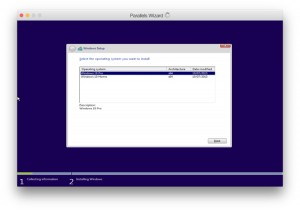
- #Mac parallels windows 10 hard reboot how to
- #Mac parallels windows 10 hard reboot mac os x
- #Mac parallels windows 10 hard reboot windows 10
- #Mac parallels windows 10 hard reboot software
It will even download the Windows 11 VHDX for you: Parallels goes out of its way to show Windows front-and-center, even though Microsoft barely supports this with a VHDX disk image of the latest ARM64 Windows 11 Insider Preview build. Next, you get a choice of OSes to install. As there can be a lot of confusion around what you can (ARM64) and can’t (Intel) emulate on an M1 Mac, Parallels needs to start with a screenful of information: You typically start off with a virtualization solution by creating a VM, so let’s start there. So what’s the difference? Let’s do a quick comparison.
#Mac parallels windows 10 hard reboot software
VMware then later released a tech preview for their own VMware Fusion software (free while in preview). Initially, the only option for running virtual machines on M1 Macs was Parallels Desktop, so that’s where I started. (You might think the first VM was a Windows VM, but that’s not the case, the first was a Fedora 34 Linux installation. Not surprisingly, the first thing I wanted to do on it was to run virtual machines.
#Mac parallels windows 10 hard reboot mac os x
Enable file sharing between Mac OS X host and Virtual Machines, would allow you to copy files from Mac into NTFS files system.I have a Mac Mini with the original ARM-based M1 chip. You will have all access to write and read files on this partition. With any luck your Windows NTFS formatted Drive should show up in your Virtual Machine’s Windows OS.įrom there you can treat this as any normal hard drive / partition.
#Mac parallels windows 10 hard reboot windows 10
Now Power On your virtual machine from Parallels, in my case, I have Windows 10 running. For some reason, if you have that checked, I’m not able to get this to work after power on the virtual machine.īefore Power On your virtual machine., go to your Disk Utility > (I’m running the latest Mac OS X El Capitan Developer preview, it could look different if you are running this on older Mac) ensure to Unmount the actual partition(s)Īfter the partition ejected from Mac, you should see the NTFS drive grey’d out. Make sure to uncheck Connected, check box for the newly added Hard Disk.

Select OK to finish adding the Hard Disk. When prompt for the type, select “Boot Camp”Īt this point if you already have the external USB plugged in, it should recognize and populate the drive for you under Location. Under Hardware Tab, you need to add a new hard disk. Now before you start up your Windows Virtual Machine, go to Configure > Devices (tab) to make sure you are selecting “Ask me what to do” when a new external device is detected.

In this case, assuming you have an external USB drive with NTFS file format using Parallels and a running Windows virtual machine you can write files to NTFS file format straight from your Mac.įirst, make sure Parallel’s preference is set to allow you pick and choose which OS to point to when you plugin your USB drive.
#Mac parallels windows 10 hard reboot how to
How To Leverage Parallels To Write Files to NTFS File System Drive Since Parallels doesn’t have a straightforward documentation explaining how to do this, I will take this opportunity to share with you. After all, if you are running a Windows Virtual Machine on your Mac, you should be allowed to write files to NTFS.

This guide will leverage Parallels and Windows VM/ Bootcamp as a bridge to allow user perform write operations to NTFS file format drives. There are many ways you can overcome this limitation if what you need is not only to read files from NTFS, which Mac OS X supports natively out of the box. While some of this are due to technical limitations, majority of the reasons are bounded by the business decisions not supporting the most popular Windows file system format, NTFS. Mac does not allow write files to NTFS file format drive, it has been like this for many years.


 0 kommentar(er)
0 kommentar(er)
